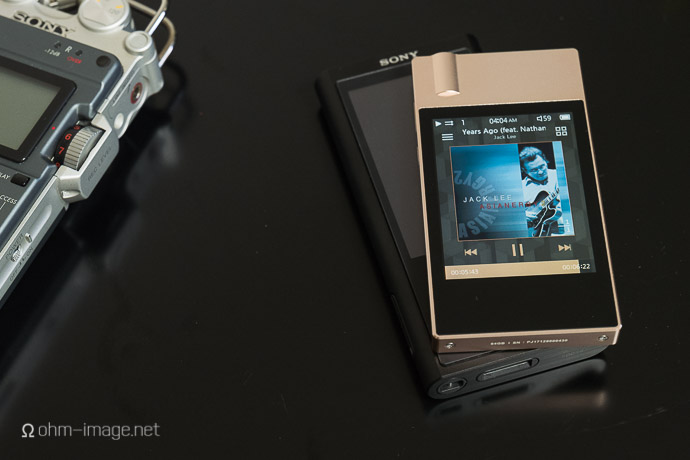Disclaimer: The star of this weeks’ picture Sunday is the Cowon Plenue J. This post is a part of our Picture Sunday series.
On a scale of sleek from 1 to Plenue J, the gold Plenue J is a Plenue J. It is pretty, slim, easy to control, and machined as well as I’ve seen in any player at any price. I’m reasonably sure that my glasses aren’t rose tinted, but its gold is ever so daintily tinted rose. Pretty!

It came snug in a small box, and two bolts keep it snugly fit together. Like Sony’s ZX300, its back is clad in non-stick rubber; through that the Plenue logo pokes through. Unlike the ZX300 the non-slipness of that non-slip surface is academic. Its stereo jack housing, whose raised walls prop the Plenue J up on metal rather than rubber bits. Its non-stick parts rarely touch anything. Consequently, on slippery surfaces it slips as much as an iPhone or Astell & Kern AK70/ii.

Whatever.
Best and most slick of all is its playback interface, wherein a flick forward or back will track in the corresponding direction. It’s navigation and volume buttons are linked, and despite being much smaller and even more tightly spaced, easier to use than the ZX300’s. They’re a bit psychotic, though: the up tracking button moving to the previous rather than next track. Volume, on the other hand, works as labelled: up to raise, down to lower. Okay…

It screen is kind of a downer, being similarly washed out, dull, and low resolution to the Plenue D. Of course, at this price point that’s pretty much par for the course. Onkyo’s DP-S1 is just as bad. It’s just that you’d think that newer screens would be much better than early AK100 screens from six years ago.
I never synced the 66GB of music I thrust into the Plenue J’s micro SD card slot. Wordlessly, soundlessly, and without hassle, the J synced the entire thing, seamlessly merging internal and external libraries so that Cydonia, Disintegration, and Galore-1997 on the 200GB micro SD card show up right next to RMAA and square wave test albums internally installed. Brilliant. And hi-res albums play without a hitch. Long-time Cowon features: AB playback, BBE effects, parametric EQs, and even reverb effects apply as they have always. Its myriad effects make your music really yours. If you want to know how it performs check this out: RMAA: Cowon Plenue J 24-bit.
Plenue J sports battery life that lasts a couple of days, but not as far into the work week as the Plenue D. It is slicker, and more responsive, and ultimately more sexy than the D.
Relevant links:
RMAA: Cowon Plenue J 24-bit
RMAA: Cowon Plenue D 24-bit
RMAA: Astell&Kern AK70 MKII
RMAA: Astell&Kern AK70 24-bit
RMAA: Onkyo DP-S1 rubato 24-bit
RMAA: MS-AK100 24-bit new









BOTS
Up-track button moves “up” the playlist (i.e. the previous track), while the down-track button goes “down” the playlist (i.e. the next track). Sounds pretty straightforward to me.
ohm image
Philosophically, we are socialised to equate up with forward and down with back, and this breaks that simple philosophical connection humans have built up since practically forever, and which works against the interfaces of practically every device out there. Therefore, it is poor design.
dale thorn
It gets far worse with Apple. Imagine you just typed 500 words on your iPad or iPhone without saving all of it, then you attempt to swipe up. But as things sometimes happen, your finger sticks a little and moves sideways a hundredth of an inch, which Apple interprets as a left-swipe, which takes you to the page previous to your current page, and when you go back (if you can), all of your unsaved text is lost. But you can control the swipe options, yes? Sometimes you can, sometimes you can’t, but even if you could some of the swipes override the settings because it’s Tuesday or whatever.
ohm image
That may be. I’ve been able to get all my text back despite swiping left or right. But, that is another matter anyway. This isn’t about text input or saving of that text between web or notes; it’s about a breaking of long-held playback interface standards.
BOTS
Not sure I agree with your view that there is only one Correct way in which forward-backward functionality should match up with up-down directionality, but I grant that that is a very subjective topic.
In any case, doesn’t the AK70 use the exact same tracking design (up-previous/down-forward) as the Cowon? I don’t remember you guys having an issue with it in your AK70 review. Just looking for some consistency here!
ohm image
Fair point: The AK70 (1st gen) has the smallest, hardest to press buttons that I never use them. Horrible design- unless you’re a gerbil. Should I have pointed that out? Probably. But I don’t work on a template. That is a problem. I should.